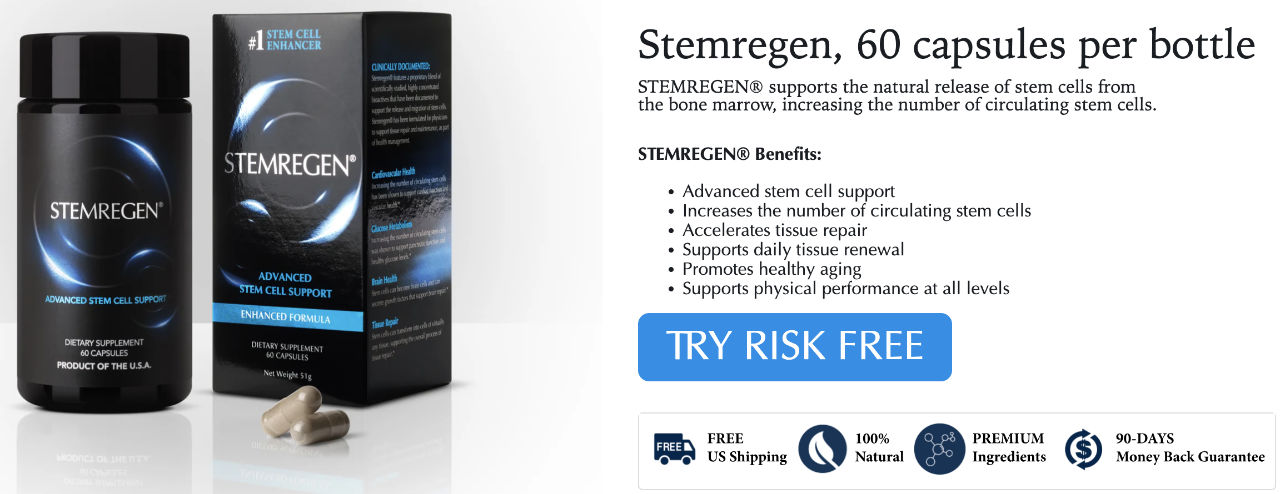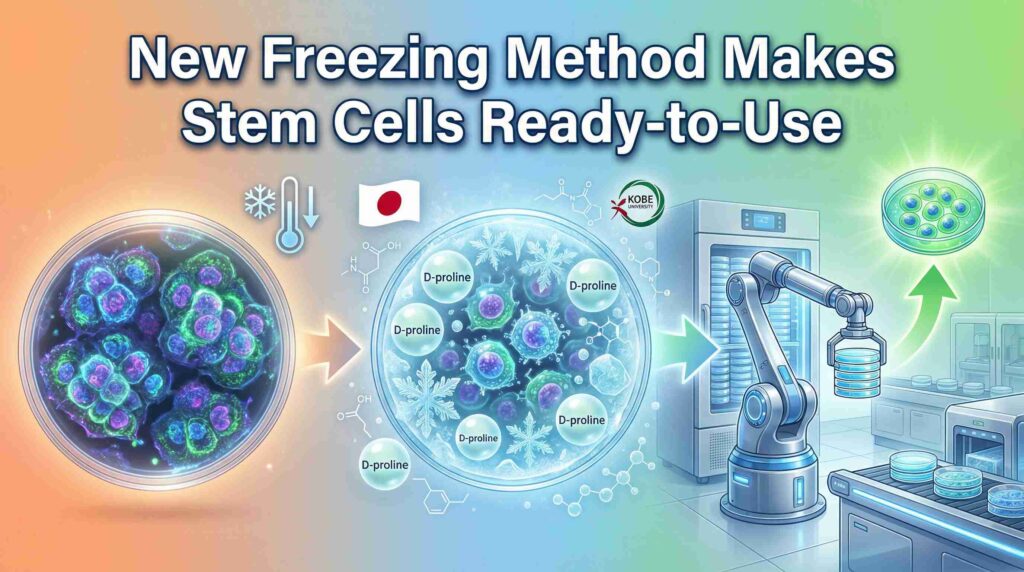Remember when you were a kid and scraped your knee? Within days, the wound would disappear like magic. Now, that same small cut seems to linger for weeks.
Have you noticed that your bruises take longer to fade? Does your back ache persist after a workout that used to leave you feeling energized? Do you find yourself saying, “I just don’t bounce back like I used to”?
You’re not imagining this change. There’s real science behind why your body heals slower as you age, and the answer lies in a dramatic decline happening inside your body right now.
The culprit? Stem cell decline – a process so significant that by your thirties, you’ve lost nearly 90% of these crucial healing cells. This isn’t just aging; it’s your body’s repair system shutting down piece by piece.
But here’s the encouraging news: understanding this process is the first step to doing something about it.
The Shocking Truth About Stem Cell Loss
Your body came equipped with an incredible healing system powered by stem cells. These master cells can transform into any type of cell your body needs for repair. Think of them as your personal medical team, working 24/7 to fix damage and keep you healthy.
But this team is shrinking fast.
The Stem Cell Decline Timeline
| Age | Stem Cell Count | What You Notice |
|---|---|---|
| Birth | 100% | Perfect healing capacity |
| Age 10 | 75% | Quick recovery from injuries |
| Age 20 | 50% | Still bounce back easily |
| Age 30 | 25% | First signs of slower healing |
| Age 40 | 15% | Noticeable recovery delays |
| Age 50 | 10% | Chronic issues begin |
| Age 60+ | 5% | Significant healing problems |
This decline explains why a paper cut that healed in two days during your twenties now takes a week or more in your forties.
What Happens When Stem Cells Disappear
Stem cells serve as your body’s construction crew. When they decline, every repair project in your body slows down or stops entirely.
Your Body’s Repair Process
Here’s how healing normally works:
- Injury Detection: Your body identifies damaged tissue
- Signal Release: Chemical messengers call for help
- Stem Cell Mobilization: Repair cells rush to the scene
- Transformation: Stem cells become the exact cell type needed
- Repair Completion: New, healthy tissue replaces damaged areas
When you have fewer stem cells, this process breaks down at step 3. Your body sends out distress signals, but fewer repair crews respond.
The Cascade Effect
Stem cell decline creates a domino effect throughout your body:
Immediate Effects:
- Cuts heal slower
- Bruises linger longer
- Muscle soreness persists
- Energy recovery takes more time
Long-term Consequences:
- Joint pain increases
- Skin loses elasticity
- Organ function decreases
- Immune system weakens
The Science of Cellular Aging
Scientists have identified the exact mechanisms behind stem cell decline. Understanding these processes helps explain why aging affects healing so dramatically.
DNA Damage Accumulation
Every day, your cells face attacks from:
- Free radicals from normal metabolism
- Environmental toxins and pollutants
- UV radiation from sunlight
- Stress hormones from daily life
Young stem cells can repair this damage quickly. But as cells age, their repair mechanisms slow down. Damaged DNA accumulates, and cells either die or stop functioning properly.
Telomere Shortening
Telomeres are protective caps on your chromosomes, like plastic tips on shoelaces. Every time a cell divides, telomeres get shorter. When they become too short, the cell can no longer divide and dies.
Stem cells divide frequently to create new repair cells. This constant division shortens their telomeres faster than other cells, leading to earlier death and fewer available repair cells.
Cellular Senescence
Some damaged cells don’t die – they become senescent. These “zombie cells” stop dividing but remain in your tissues, releasing inflammatory chemicals that damage nearby healthy cells.
Senescent cells accumulate with age, creating a toxic environment that further reduces stem cell function and survival.
Why Modern Life Accelerates Stem Cell Loss
While stem cell decline happens naturally with age, modern lifestyle factors speed up this process dramatically.
The Major Accelerators
Chronic Stress
- Elevates cortisol levels constantly
- Damages stem cell DNA
- Reduces stem cell production
- Impairs healing signals
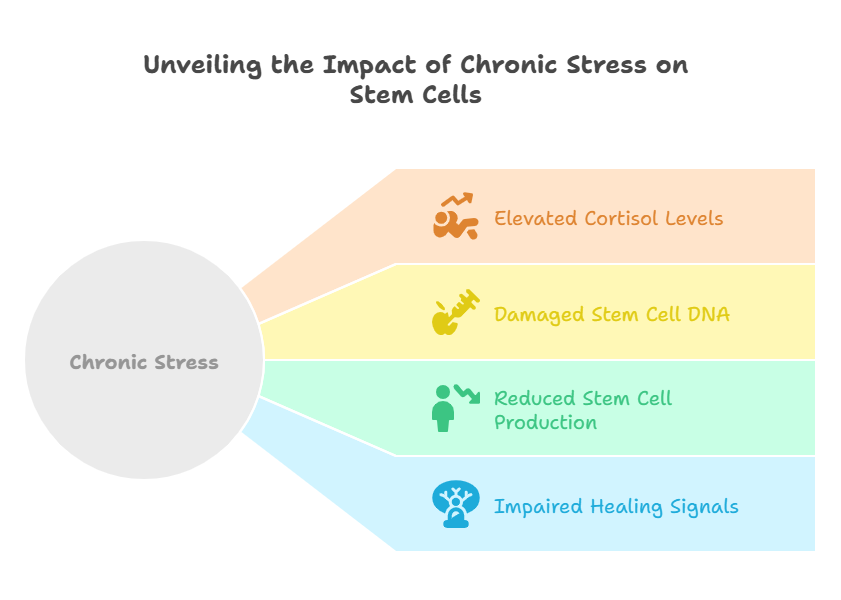
Poor Sleep Quality
- Disrupts growth hormone release
- Prevents cellular repair processes
- Increases inflammatory markers
- Reduces stem cell activity
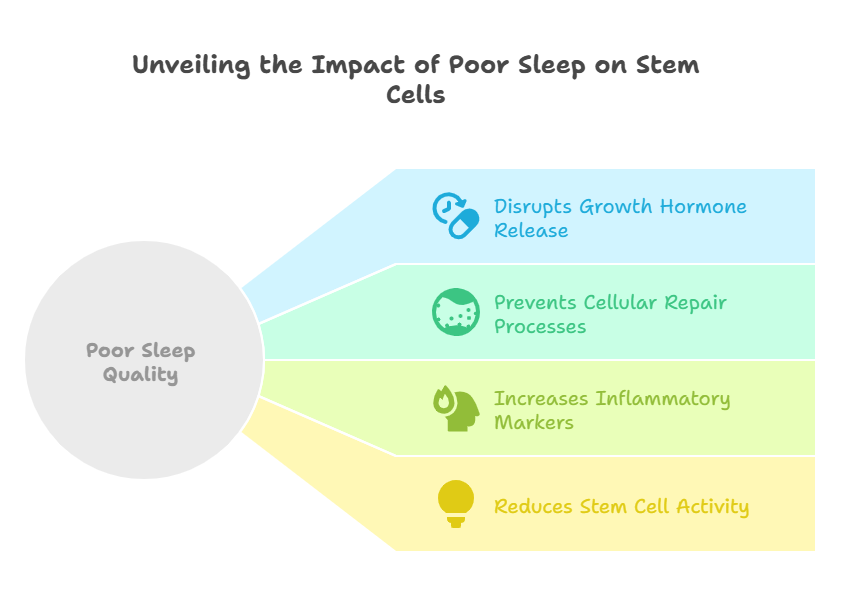
Inflammatory Diet
- Processed foods create inflammation
- Sugar damages cellular structures
- Trans fats impair cell membranes
- Lack of antioxidants allows damage
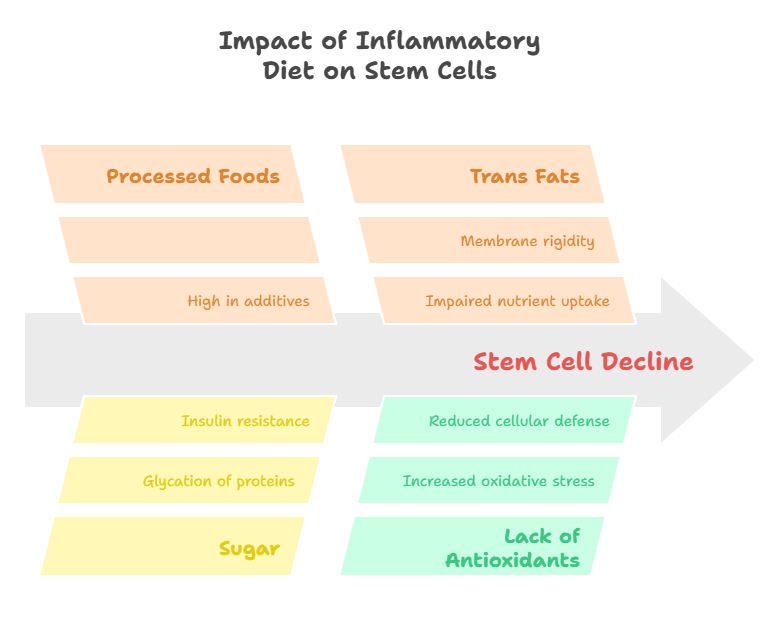
Sedentary Lifestyle
- Reduces circulation to tissues
- Decreases stem cell mobilization
- Weakens muscle stem cell pools
- Slows metabolic processes
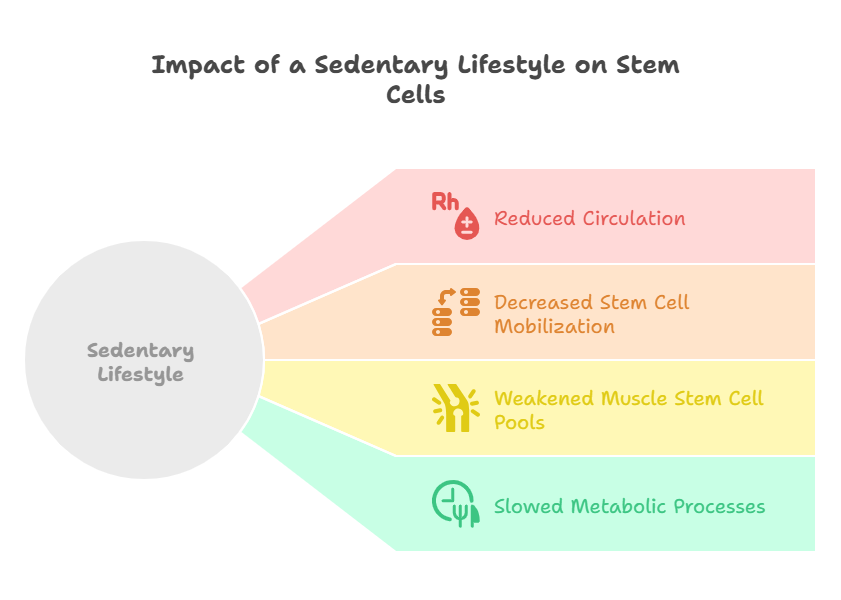
Environmental Toxins
Modern life exposes us to thousands of chemicals that previous generations never encountered:
| Toxin Source | Impact on Stem Cells |
|---|---|
| Air Pollution | Damages respiratory stem cells |
| Plastic Chemicals | Disrupts hormonal signals |
| Pesticides | Kills beneficial gut bacteria |
| Heavy Metals | Accumulates in bone marrow |
The Hidden Signs of Stem Cell Decline
Stem cell decline doesn’t happen overnight. Your body sends warning signals long before major health problems appear.
Early Warning Signs
Physical Changes:
- Small cuts take longer to heal
- Bruises fade more slowly
- Exercise recovery extends
- Joint stiffness increases
- Skin texture changes
Energy Changes:
- Afternoon fatigue becomes common
- Sleep doesn’t feel refreshing
- Mental clarity decreases
- Motivation drops
- Stress tolerance reduces
Performance Changes:
- Workout intensity decreases
- Coordination suffers
- Balance becomes less stable
- Reaction time slows
- Memory lapses increase
Advanced Warning Signs
When stem cell decline progresses further, more serious symptoms appear:
- Chronic pain that doesn’t improve
- Frequent infections or slow recovery from illness
- Significant weight gain or loss
- Depression or anxiety increases
- Multiple health issues develop simultaneously
The Healing Comparison: Young vs. Aging Bodies
To understand stem cell decline impact, let’s compare how the same injury heals in young versus aging bodies.
Paper Cut Healing: Age 20 vs. Age 50
Age 20 Healing Process:
- Day 1: Bleeding stops within minutes
- Day 2: Scab forms, inflammation peaks
- Day 3: New skin cells rapidly multiply
- Day 4: Scab begins to fall off
- Day 5: Healing complete, no scar
Age 50 Healing Process:
- Day 1: Bleeding takes longer to stop
- Day 3: Scab forms slowly, stays inflamed
- Day 7: Minimal new skin cell growth
- Day 10: Scab still firmly attached
- Day 14: Finally heals, often with scarring
The difference? The 20-year-old has abundant stem cells ready to transform into skin cells. The 50-year-old has far fewer stem cells available for repair.
Organ-Specific Stem Cell Decline
Different organs lose stem cells at different rates, explaining why some body systems age faster than others.
Skin Stem Cells
Decline Rate: Moderate Visible Signs: Wrinkles, age spots, slower wound healing Timeline: Noticeable changes begin in late twenties
Muscle Stem Cells
Decline Rate: Rapid after age 40 Visible Signs: Muscle loss, weakness, slow recovery Timeline: Accelerates significantly in forties and fifties
Brain Stem Cells
Decline Rate: Gradual but steady Visible Signs: Memory issues, slower processing Timeline: Subtle changes begin in thirties
Bone Marrow Stem Cells
Decline Rate: Severe Visible Signs: Weak immune system, anemia Timeline: Major decline starts in thirties
The Inflammation Connection
Chronic inflammation both causes and results from stem cell decline, creating a vicious cycle that accelerates aging.
How Inflammation Damages Stem Cells
- Direct Damage: Inflammatory chemicals kill stem cells
- DNA Harm: Free radicals damage stem cell genetic material
- Signal Disruption: Inflammation blocks healing messages
- Environment Toxicity: Creates hostile conditions for stem cells
Common Sources of Chronic Inflammation
- Poor diet high in processed foods
- Lack of regular exercise
- Chronic stress and poor sleep
- Environmental toxins
- Gut bacteria imbalances
- Hidden infections
Breaking the Decline Cycle
The good news is that stem cell decline isn’t completely inevitable. Research shows you can slow, stop, and even reverse some aspects of this process.
Proven Strategies to Support Stem Cells
Exercise: The Stem Cell Booster
- Increases stem cell production by up to 300%
- Improves circulation to deliver stem cells
- Reduces inflammation throughout the body
- Stimulates growth hormone release
Nutrition: Fuel for Repair
- Antioxidants protect stem cells from damage
- Omega-3 fats reduce inflammation
- Protein provides building blocks for new cells
- Phytonutrients activate repair genes
Sleep: The Repair Window
- Growth hormone peaks during deep sleep
- Cellular cleanup processes activate
- Inflammatory markers decrease
- Stem cell production increases
Stress Management: Protecting Your Repair System
- Meditation reduces cortisol levels
- Social connections boost immune function
- Purpose and meaning improve cellular health
- Relaxation techniques enhance repair
Foods That Support Stem Cell Health
| Food Category | Examples | Key Benefits |
|---|---|---|
| Antioxidant Rich | Berries, dark chocolate, green tea | Protect cells from damage |
| Anti-inflammatory | Fatty fish, turmeric, leafy greens | Reduce harmful inflammation |
| Stem Cell Activators | Broccoli sprouts, green tea, blueberries | Stimulate stem cell production |
| Repair Nutrients | Bone broth, eggs, nuts | Provide building materials |
The Future of Stem Cell Health
Scientific research continues to reveal new ways to support your body’s natural healing system. Recent breakthroughs include:
- Plant compounds that boost stem cell activity
- Lifestyle protocols that reverse cellular aging
- Natural methods to increase stem cell numbers
- Personalized approaches based on individual genetics
Taking Action Today
Understanding stem cell decline is powerful, but taking action is what creates real change in your health.
Start With These Simple Steps
- Move Your Body Daily
- Take a 30-minute walk
- Add strength training twice weekly
- Include stretching and balance work
- Eat Stem Cell Supporting Foods
- Fill half your plate with colorful vegetables
- Include omega-3 rich foods daily
- Reduce processed food consumption
- Prioritize Recovery
- Aim for 7-9 hours of quality sleep
- Practice stress management techniques
- Allow adequate rest between workouts
- Reduce Inflammation
- Limit sugar and processed foods
- Manage stress effectively
- Consider natural anti-inflammatory compounds
The Bottom Line
Your body’s healing capacity doesn’t have to decline dramatically with age. While some stem cell loss is natural, much of what we consider “normal aging” is actually preventable decline.
The key is understanding that your stem cells need support to function optimally. Every positive change you make helps preserve and enhance your body’s natural repair system.
Remember: it’s never too early or too late to start supporting your stem cell health. Your future self will thank you for the actions you take today.
